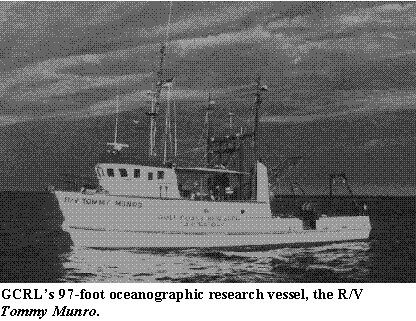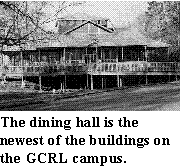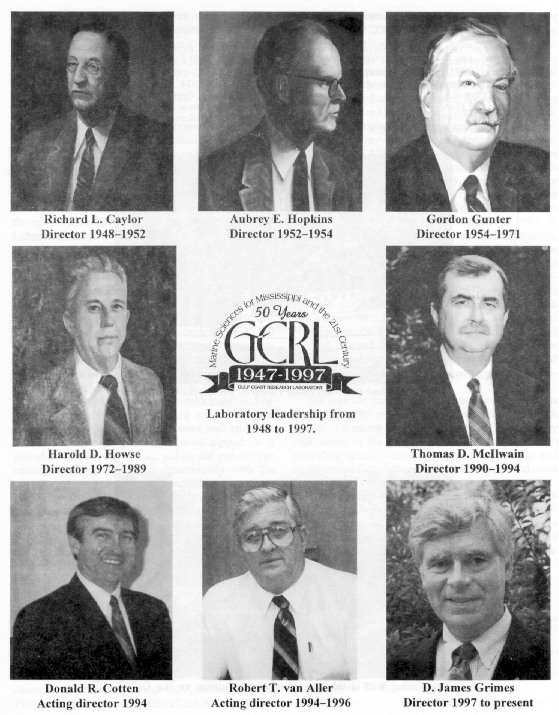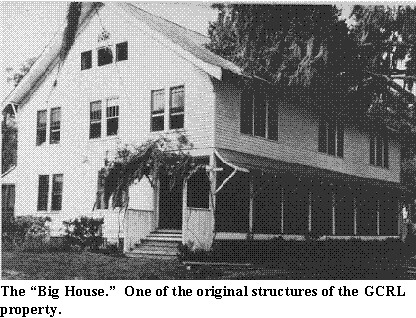
A Mississippi Academy of Sciences Project that Has Come of Age
Linda Skupien and Joyce M. Shaw
Institute of Marine Sciences, P.O. Box 7000, Ocean Springs, MS 39566-7000
A brief overview of the creation and growth of the Gulf Coast Research
Laboratory, this article traces the institution's history and its strong
relationship with the Mississippi Academy of Sciences. The Mississippi
Academy of Sciences officially dedicated the Gulf Coast Research Laboratory
(GCRL) with the opening of the first summer session at Magnolia State Park
in Ocean Springs, Mississippi, on August 28, 1947. Mississippians in scientific
and educational circles had worked for two decades toward creating a research
and educational laboratory focused on the state's marine and coastal environments.
The Academy's priorities were scholarly research and education. Political
leaders were interested in the potential for a direct effect on the economy
of Mississippi. The evolution of that two-fold focus has created a unique
institution that integrates scientific discovery with graduate, undergraduate
and public education as well as with rapid and effective response to questions
of public concern.
On August 28, 1947, the Mississippi Academy of Sciences officially dedicated the Gulf Coast Research Laboratory (GCRL) with the opening of the first official summer session at Magnolia State Park in Ocean Springs, Mississippi. That event marked the culmination of more than two decades of effort by Mississippians in scientific and educational circles who had seen the need for a research and educational laboratory focused on the marine and coastal environments of Mississippi. The future of the fledgling laboratory would also be influenced by local and state political leaders who saw the new facility as an institution that would allow for "the investigation of the propagation, life histories, control and protection of marine organisms now proving to be of commercial value in the coastal areas." GCRL emerged with several purposes. The highest priority for the Academy was scholarly research and education. For political leaders the priority was research that was expected to have a direct effect on the economy of Mississippi (Bailey, 1995).
The evolution of the two-fold focus of scholarship versus immediate impact set into motion a creative tension still at work today as GCRL administrators, researchers, and educators merge sometimes contrasting missions, approaches, priorities and perspectives. GCRL scientists, their graduate students and their technical staff explore fundamental questions about the plants, animals and processes of Mississippi's marine environments. At the same time, they have a firsthand relationship with the practical realities and the concerns encountered by the people who live, work and play in those environments. The result is a unique institution that integrates scientific discovery with graduate, undergraduate and public education as well as with rapid and effective response to questions of public concern.
INSTITUTE OF MARINE SCIENCE
The present-day Gulf Coast Research Laboratory is a component of The University of Southern Mississippi's Institute of Marine Sciences. In March 1996 Mississippi's Board of Trustees of the Institutions of Higher Learning created the Institute by merging the Laboratory, GCRL's J.L. Scott Marine Education Center and Aquarium, and the former USM Center for Marine Sciences at Stennis Space Center. GCRL is located on a 50-acre site in Ocean Springs and is adjacent to the Mississippi Sound. The campus is surrounded by bayous and salt marshes that provide a natural laboratory for researchers and students. GCRL's 21 buildings house research and teaching laboratories, classrooms and offices where more than 160 researchers, technical and support personnel, and graduate and undergraduate students work.
The Laboratory is home to the Gunter Library, one of the most extensive marine science libraries in the northern Gulf of Mexico region. The Laboratory's Ichthyological Research Collection includes more than 200,000 fish specimens from around the world. Among the Laboratory's vessels are the R/V Tommy Munro, a 97-foot oceanographic research vessel, the 38-foot wooden trawler, the M/V Bill Demoran, and the 38-foot steel M/V Hermes.
On the Laboratory's Biloxi campus, the J.L. Scott Marine Education Center & Aquarium houses Mississippi's largest public aquarium and features marine educational programs and firsthand experiences for Mississippi residents and visitors of all ages. More than 75,000 children and adults visit the Center each year. Approximately 30,000 of the Center's yearly visitors are involved in the hands-on education programs that have earned the Center an international, award-winning reputation. The facility's 48 aquariums, arranged around the 42,000-gallon Gulf of Mexico tank, showcase native creatures typical of Mississippi's waters from freshwater streams to open ocean.
The third component that has joined the Laboratory as part of the Institute is USM's Marine Science Program located at the Stennis Space Center near Bay St. Louis, Mississippi. The concentration of oceanographic and space agencies at Stennis affords IMS faculty scientists, science educators, researchers, and graduate and undergraduate students opportunities to establish collaborative relationships among nearly 4,000 scientists, engineers and technical personnel. The Maury Oceanographic Library, one of the world's largest, and two super computers located at Stennis comprise a valuable part of the infrastructure that supports the IMS oceanography program.
Research at GCRL focuses in five major areas: marine aquaculture, biodiversity and systematics, coastal ecology, environmental fate and effects, and fisheries science. Complementing these research areas are those of the Marine Science Program at Stennis: paleoceanography, carbon and nutrient cycling in coastal environments, modeling the ocean and its systems, wave-current interactions, phytoplankton ecology, marine community dynamics, hydrology, antarctic ecosystems, and marine chemistry.
EARLY DAYS
The breadth of the Gulf Coast Research Laboratory's programs had its beginnings in the vision of Missisippians prior to World War II. An early Gulf Coast Research Laboratory bulletin identified Mississippi State College professors as first planting the seeds for the emphasis of the Laboratory's educational focus:
"The earliest attempt to establish a Laboratory on the Gulf Coast, according to Dr. Clay Lyle, Head of the Department of Zoology and Entomology of Mississippi State College, was initiated by his predecessor, Dr. R.W. Harned. Dr. Lyle stated that he has found in his files correspondence which indicated that considerable effort was made during the early 1920s by Dr. Harned and Col. H. D. Money of Biloxi, Mississippi, to establish a Research Laboratory on the Coast."
State Geologist Dr. H.M. Moore actively promoted the idea in the Academy, and a coastal research laboratory was regularly a matter of discussion in business sessions of the organization. Academy member R.L. Caylor, later appointed first director of the Gulf Coast Research Laboratory, was using the Mississippi Gulf Coast as a laboratory for his summer field courses.
Robert J. Bailey, in his History of the Mississippi Academy of Sciences: It's First Fifty Years, said of Caylor's activities: "It is appropriate to point out at this time that an energetic biology professor at what was then Delta State Teachers College conducted summer field schools on the Mississippi Gulf Coast in 1935 and 1937. He addressed the 1938 annual meeting on 'Some Research Possibilities along the Mississippi Gulf Coast.' His name was R.L. Caylor, and his work was certainly a forerunner of the Laboratory."
Caylor also conducted field trips to the Coast in the summers of 1940 and 1946. The Delta State professor and a group of 20 students made Magnolia State Park, now part of the Gulf Islands National Seashore, their headquarters for the 1946 field course. The Academy accepted an invitation to hold a special session at Magnolia State Park. Bailey chronicled the session that started on August 15, 1946:
"After several days of intensive discussion, an ad hoc committee was established and charged with the responsibility of studying the feasibility of establishing a marine research and teaching laboratory. . . On August 23, 1946, the committee offered its proposal that the Academy should establish GCRL."
The Academy membership approved a resolution on May 2, 1947, in the annual regular meeting to take the steps needed to establish the Gulf Coast Research Laboratory:
Whereas the Mississippi Academy of Sciences desires to further its work in promotion of scientific research, and to establish and maintain a laboratory on the Mississippi Gulf Coast to be known as the Gulf Coast Research Laboratory;
It is hereby resolved that in order to meet the need of incorporation of the Mississippi Academy of Science, Dr. Clyde Q. Sheely, Dr. Ray J. Nichols, Dr. Clytee R. Evans, Dr. Charles L. Deevers, Dr. W.E. Riecken, and Professor John M. Frazier be appointed and authorized by the Mississippi Academy of Science to apply to the Secretary of State of the State of Mississippi for a charter of incorporation, such corporation to be known as the Mississippi Academy of Sciences, Incorporated.
The Academy's 1947 meeting minutes also show the appointment of a Gulf Coast Scientific Research Laboratory Committee. The nine members included the incorporation committee members with the addition of Caylor, G.N. McIlhenry and E.G. Breu. The charter of incorporation of the Mississippi Academy of Sciences, Incorporated was recorded in the records of incorporation of the Mississippi Office of the Secretary of State on July 23, 1947. The charter was the Academy's "business license" to establish and maintain a scientific research laboratory and to conduct the financial and other activities necessary to accomplish that purpose. Academy members had discussed incorporation of the Academy as early as 1939.
"In 1947, it became a reality, and the impetus for the Academy's incorporation was the creation of R.L. Caylor's and others' long-hoped-for Gulf Coast Research Laboratory (GCRL)," Bailey recounted. Caylor and the Academy considered the 1947 summer session as the first GCRL class of summer students. Twenty-six students and three staff members participated in the two-week session at Magnolia State Park.
Caylor also pushed the creation of the Laboratory with the Mississippi Board of Trustees of the Institutions of Higher Learning. In a May 5, 1997, letter prompted by the faculty and staff celebration of GCRL's 50 years, former IHL official J.L. Scott of Jackson recalled Caylor taking the laboratory idea to the IHL.
"A science professor, Dr. R.L. Caylor from Delta State Teachers College, came by the Board office in the late summer . . . and talked to the Executive Secretary of the Board, Dr. E.R. Jobe, about establishing a center on the Coast to be used by the Mississippi Academy of Sciences. The graduating students who were going into the schools as teachers could not identify marine life or semi-tropical plant life that they would be teaching about in the high schools.
"Dr. Jobe and I agreed with Dr. Caylor. We discussed the idea with Board members and concluded that this would enhance the [state's] science programs. The Board directed that we find a suitable site and report back for final action. This search for a suitable site was an easy task. Since we [the IHL] had no funds the Magnolia State Park was the best location."
Scott recalled the Board of Trustees was in favor of the preparation of a bill establishing a Laboratory on the coast and in the Magnolia State Park. Board member John Savage of Gulfport and Jobe comprised the committee charged with composing the bill. Scott worked with the committee to draft the legislation. The 1948 session of the Mississippi Legislature approved the bill, stipulating that the Laboratory be located on Magnolia State Park property, that it be operated by the Mississippi Academy of Sciences under the supervision and control of the Board of Trustees of the Institutions of Higher Learning, and that the Board of Trustees expend out of the IHL appropriation a sum not to exceed $5,000 annually [Miss. Code Ann. § 37-101-19 (1997)].
GCRL enthusiasts forged ahead in spite of obstacles. Scott described the old Civilian Conservation Corps buildings--the living facilities for summer session participants--as a "semi-camp out." He rounded up buildings and equipment valued at $260,000 through the Federal Security Agency.
"We acquired 'surplus property' equipment for a dining area and kitchen, and other furniture just to exist. In 1949 our dining hall burned in the middle of night. We were never able to determine the cause of the fire, but were convinced that this was not the best location for the laboratory."
Bailey noted that it was apparent that the Magnolia State Park site was not sufficient for the Laboratory's expected growth and expansion. "Further, the State Building Commission turned down numerous requests for funds to construct new facilities for the Laboratory or reconstruct surplus equipment and buildings, which had been pledged to the Academy and the college board by the Federal Security Agency," Bailey recorded.

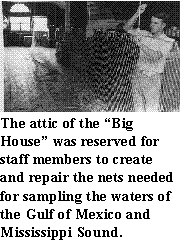
Gulf Coast Research Laboratory advanced another step on February 11, 1949, when the IHL established the research laboratory as "a separate and independent institution of higher education and research in Mississippi to be operated by the Mississippi Academy of Sciences." Soon after that IHL action, negotiations turned serious for purchase of the present location, property just across the bayou from Magnolia Park that had recently become available. Bailey's history describes this property as the former estate of D.A. Smart, who at one time was an editor of Esquire magazine. Under consideration was the 39-acre site that included a large two-story house, affectionately termed "the Big House," by later Laboratory employees, a garage apartment, a greenhouse, an artesian water well, 1,600 feet of beach front, two 36-foot boats and dock facilities. The Laboratory's broad support was evident in the negotiations. Participating were Academy members, IHL Board of Trustees President Martin V.B. Miller, the Jackson County Board of Supervisors under the leadership of Board President Fred Moran of Ocean Springs, state legislators from the coast and the Ocean Springs Chamber of Commerce (Howse, 1992).
Support by the State Building Commission remained limited, much to the frustration of Caylor and his colleagues. Jobe, IHL executive secretary, led the Academy to press home points likely to garner support with the commission and the state legislature:
that the Academy recognized that it was not in a financial position to assume full control of the Laboratory;
that it was willing for IHL to assume full responsibility for the operation and maintenance of the facility;
that the MAS would be content to serve in an advisory role;
and that the MAS would not support the concept that the Laboratory should come under the jurisdiction of any one senior college or university.
The state increased support and purchased the Smart property for $35,000. The 1950 session of the Mississippi Legislature approved a bill that established the Laboratory as a corporate entity within state government, operating under the administration of the IHL and located within the state on the Gulf of Mexico [Miss. Code Ann. § 37-101-19 (1997)]. As the first director, Caylor continued to work toward establishing adequate physical facilities.
"He never let a week pass that he did not call me for help on needed equipment or facilities," Scott said. "Dr. Caylor's requests came before the Board so often that at one of the meetings Mr. Charles Fair, the president of the Board instructed Dr. Jobe not to worry about putting the requests on the agenda. 'Just let Jake do it.' From then on I just reported monthly what I had done for and with the GCRL."
As Scott shepherded the acquisition and construction, he joined the ranks of Caylor, numerous Academy members and individuals in the public and private sectors who developed a passion about the marine laboratory and devoted exceptional personal and professional effort to its survival and growth. Scott recalled the day that Mississippi Governor Hugh White came on board to support construction at the present-day site.
"Governor Hugh White insisted that he make all building commission trips to university and college campuses. This was part of the inspection of buildings and review requests for new buildings. The trip to GCRL was scheduled for August. We had requested funds for erection of two buildings for dormitory use. Materials had been salvaged from Pascagoula, the old shipyard cafeteria and theater building. Governor White always wore a white linen suit in summer. He and I walked out to the neatly stacked pine lumber. He sat on a stack of 2x6 timbers, and we talked about using this for our buildings. When he decided to get up, his white linen pants were stuck on the resin, and you could just hear it coming loose. Of course I apologized and offered to take them to the cleaners. He looked at me and said, 'Scott, I have been in the lumber business all my life. That is a sign that this is good lumber.' Needless to say, we received funds for the buildings."
Bailey noted that, although Caylor recognized that the immediate need for buildings could be met inexpensively with surplus lumber, he insisted that a long-term building program begin. He and the Academy's Laboratory committee met to discuss such construction with an architect (Bailey, 1993).
ACADEMICS
While Caylor and Laboratory supporters worked to create a physical plant, the director and his colleagues of the Academy were building the summer academic program. Caylor's report to the Academy in 1951 reflects their progress. The first three summer sessions--1947, 1948 and 1949--were all located at Magnolia State Park. The second session, held in 1948, was expanded to four weeks with 52 students and five staff participating. The final session at Magnolia Park was a six-week session in 1949 with 57 students and nine staff. The first summer session held on the current property was ten weeks with 54 students and seven staff (Caylor, 195153). In the early days of the Laboratory, summer classes were held outside under cover of the trees (Howse, 1992). Gordon Gunter, the Laboratory's third director, recalled a visit to the facility long before his tenure as director. "I remember what a lush, dank, seaside it was, where people worked on rough, wooden tables, under the trees" (Gunter, 1971).
In an earlier report to the Academy, Caylor captured that "under the trees" pioneer spirit of the Laboratory's educational programs, programs that continue to ignite a passion for marine science in students of all ages today. He noted that a visiting lecturer from the Texas A & M Research Foundation stated his impressions of the Laboratory in an address before the 1948 summer Laboratory group. A striking aspect to him was that "with no coercion professors and students from nearly every school in the state are working side by side, all moving in the same direction." Caylor continued, "The Laboratory operated briefly last summer, offering courses in Botany, Geology, and Zoology . . . It will operate for a longer period in 1949, offering courses in Zoology, Botany, and Geology with the addition of courses in Science for the Elementary and High School teacher" (Caylor, 194850).
Caylor held annual meetings of Academy officers and faculty representatives from Mississippi senior colleges to plan each summer's program (Walker, 1974). "The Mississippi Academy of Sciences was very active in promoting and manning the GCRL summer schools in these early years," Scott said. "There were so many Academy members who devoted complete body and soul to teaching in the summers."
Faculty and students immediately started modest research efforts, gathering specimens as a foundation for a museum collection and a preliminary inventory of the organisms of Mississippi coastal waters. Faculty were also working with taxonomists from around the U.S. on identification of the organisms (Walker, 194850).
The budding education and research efforts were enhanced in 1950 with the Laboratory's association with the Mississippi Seafood Commission. The Commission assigned the research vessel Uranus to the Laboratory for the summer. Much of the early construction activity was also a result of the association with the commission. In 1952, the time had come for a 12-month laboratory, and A.E. Hopkins, an advisor to the seafood commission and head of the commission's research program, was appointed GCRL director. Caylor remained director of the summer academic program. The move to a year-round operation opened the door for a permanent staff. Hopkins and Jackson County Senator Hermes Gautier also teamed up and successfully secured state funding for construction of a teaching laboratory and the acquisition of a research vessel.
Caylor submitted his resignation as director of the Laboratory's educational program at a December 1953 meeting of the Academy's Gulf Coast Research Laboratory Committee. In a tribute to Caylor at the Academy's April 2324, 1954, meeting, President C.E. Lane, Jr., said, "To hundreds of students he has been the Gulf Coast Laboratory just as much as the classrooms, the boat trips, and the permanent buildings one will see there. In Dr. Caylor's own words, he stayed with the Laboratory until it could be put on a permanent year-round footing. Now that this is done, he feels that he can return to summer teaching in his own department at Delta State College with the assurance that the course work and research of the Laboratory will continue" (Sheely, 194850).
Hopkins, an aquatic biologist specializing in oysters, hired William Demoran, now retired, as a second full-time staff member. "We both went to work on July 1, 1952," Demoran said in an article in the Pascagoula The Mississippi Press (Hines, 1997). Following Hopkins death in 1954, Caylor was appointed interim director for the 1955 summer program. Dr. Gordon Gunter was appointed director in 1955 and served as director until 1971. He continued his association with the Laboratory as professor of zoology and director emeritus until his retirement from active service with the State of Mississippi in 1979 at the age of 70.
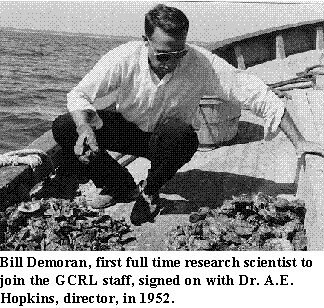
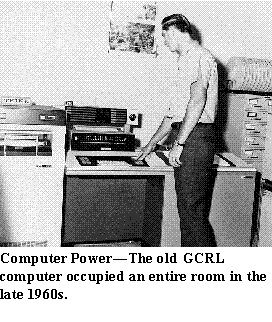
A native of Louisiana, Gunter had earned his Ph.D. from the University of Texas and had served as director of the University of Texas Institute of Marine Science at Port Aransas before coming to Gulf Coast Research Laboratory. Under Gunter's leadership, the Laboratory experienced a growth surge in the 1960s with the construction of modern buildings and the expansion of scientific staff. Construction added more than 79,000 square feet of laboratories, office space for scientific staff, classrooms and student housing. Many of the Laboratory's major buildings became a reality during Gunter's tenure as director: the Oceanography Building, the 40-room brick dormitory currently in use, the Anadromous Fisheries Research Laboratory, the R.L. Caylor Building, the maintenance shop, renovation of the A.E. Hopkins Building and the Research Building. The Laboratory's first large research vessel, the 65-foot R/V Gulf Researcher, was also completed in 1964.
James S. Franks, Larry C. Nicholson, Harriet M. Perry and Richard S. Waller, all current IMS scientific staff and fisheries biologists employed initially by Gunter, gathered at the Gunter home in Ocean Springs on August 14, 1997, for an American Fisheries Society awards ceremony. They presented the American Fisheries Society's half-century membership award to Gunter. He and his former staff members shared memories of the Laboratory's earlier days. The reminiscences continued after the visit ended.
"He is one of the great naturalists living today," Nicholson said. "He is interested in every living thing--how each species affects other species and how natural processes affect them--understanding how everything is connected."
Demoran recalled that the Laboratory launched its first major research project shortly after Gunter became director. "In 1956, we got the first contract to do serious research, a $22,000 grant to study menhaden in the Gulf of Mexico." Gunter had brought a biologist with him that increased the staff to three. An additional staff member and a boat captain were hired once the menhaden project was a reality (Hines, 1997).
As he built the scientific staff, Gunter also marshaled the essential tools for a scientist's work. High on his list of priorities was access to the scientific literature. He laid the foundation for one of the best collections of marine science publications in the Gulf of Mexico region. He established Gulf Research Reports, the scientific journal of marine sciences for the Gulf of Mexico and adjacent waters. Gulf Research Reports has published continuously since 1961.
Sustained state funding was limited, and "he donated many of the volumes for the library from his own collection," Perry said. Waller recalled that Gunter's regular practice was to accept consulting work for which he commanded remarkable fees even by today's standards. He then used the fees to buy equipment or books for the library. "One of his reasons for starting Gulf Research Reports was to establish an exchange relationship so that our library would receive scientific journals," Waller said.
CAMILLE
Natural forces battered the Laboratory's progress when Hurricane Camille
struck in August 17, 1969. In Hines' Mississippi Press article,
toxicologist David Burke recalled he had been with the Laboratory only
14 months when the killer storm swept ashore. "We thought it was probable
that we would never recover, the destruction was so complete," Burke said.
"It was summer time and we had a campus full of kids. For a 10-day period
nobody could get in or out," he said. Administrative Officer Robert Ochsner
made certain the students were safe. "He had no idea his home and family
in Gulfport had survived. He stayed put and got his work done and got word
back to frantic parents that their kids were all right," Burke said.
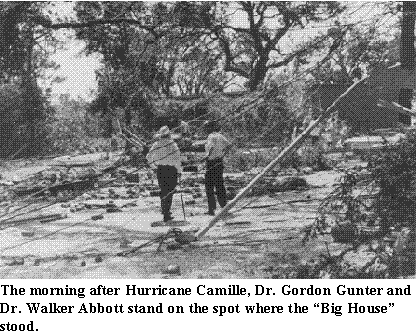
Burke cited Charles Dawson, who was section head of systematic zoology, for his leadership at that time. Dawson started the staff on the task of rolling up copper wire while he looked for a generator. He also organized the massive cleanup needed in the wake of the storm's devastation.
The response to the storm was characteristic of the staff. "We all pitched in and helped. If somebody needed help, we did it. It gave you a better insight in the field of marine science. It was a learning process" (Hines, 1997).
MODERN TIMES
The academic program continued to expand through the mid-70s. Gunter worked with colleague Harry Bennett, a former professor and dean at Louisiana State University, to put the process in place for out-of-state colleges and universities to become affiliates of the Laboratory and accept credits earned by their students at GCRL. LSU became the first of the more than 60 institutions now affiliated with the Laboratory.
Under subsequent directors Drs. Harold Howse (197289) and Thomas L. McIlwain (199094), GCRL expanded in the areas of research, public service and education. GCRL researchers continued exploring fundamental questions about Mississippi's marine resources while public service activities increased. Federal and state agencies tapped the scientific expertise at the Laboratory, contracting with GCRL to explore specific problems and opportunities related to marine resources, to craft fisheries management plans, and to put proposed solutions into effect. A number of benchmark works published by researchers during this period are still in demand today by other scientists, educators and students. While academic program enrollment dipped for a period in the mid-70s, GCRL public and pre-college education efforts expanded dramatically with the opening of an environmental education center in 1972. The facility on Point Cadet in Biloxi was the precursor of the present J.L. Scott Marine Education Center & Aquarium which opened on Point Cadet in 1984. By the late 1980s the educational programs at the center were serving as models for marine and environmental programs for teachers and students far beyond Mississippi's borders. The original environmental education center remains in use today, providing additional classroom space as the MEC&A Annex. The academic summer program also rebounded and by the early 1990s was straining classroom and dormitory facilities.
The Laboratory's relationship with the Academy remained strong through the years. GCRL's first director served as president of the Academy in 1949. Five additional past presidents of the Academy have been Gulf Coast Research Laboratory directors or scientists. GCRL scientific staff members have been active in committees and other facets of the Academy.
Further organizational changes have come to GCRL in the past decade. In 1988 the Mississippi Board of Trustees of the Institutions of Higher Learning placed the Laboratory under the administrative oversight of The University of Southern Mississippi. Following Director McIlwain's retirement, Dr. Donald R. Cotten served briefly as interim director. Dr. Robert T. van Aller served as interim director from 1994 through 1996 while continuing as USM's graduate dean. Following a national search, Dr. D. Jay Grimes was appointed director of both the Gulf Coast Research Laboratory and the Institute of Marine Sciences, coming on board in January of 1997. A microbiologist specializing in marine organisms, Grimes' research administration experience includes directing the New Hampshire Sea Grant College Program and the U.S. Department of Energy's microbial genome and bioremediation programs. His research and administrative experience have made him a strong proponent of the integrated activities that characterize GCRL: a combination of basic and applied research, rapid transfer of technology for public and economic benefit, formal graduate and undergraduate education, and precollege and continuing education.
He sees the future of GCRL and the Institute as limited only by availability and conditions of work space. In a recent interview he cited GCRL as a key component in the growth of the IMS as a leader in providing science-based solutions to economic and environmental challenges facing Mississippi and other coastal states of the Gulf of Mexico.
"Gulf Coast Research Laboratory is no newcomer," Grimes said. "GCRL has been here for 50 years. The people and priorities of GCRL are major factors in my certainty that we will fulfill the vision of the Institute as the preeminent marine sciences institution on the Gulf of Mexico."
LITERATURE CITED
Bailey, R.J. 1995. History of the Mississippi Academy of Sciences: Its First Fifty Years. J Miss Acad Sci. Vol. 38 (2) supplement August/September. 46 pp.
Caylor, R.L. 19481950. Mississippi on the March with Science. J Miss Acad Sci 4:9297.
Caylor, R.L. 19511953. Activities of Gulf Coast Research Laboratory. J Miss Acad Sci for 5:3640.
Gunter, Gordon. 1971. Twenty-fifth Anniversary Ceremonies for Gulf Coast Research Laboratory. J Miss Acad Sci 17:xvixvii.
Hines, Regina. 1997. Early scientists at lab remember its roots. The Mississippi Press; Sect. B:1 (col. 4).
Howse, Harold D. 1992. Gulf Coast Research Laboratory: A Creation of the Mississippi Academy of Sciences. J Miss Acad Sci 37(2):69.
Miss. Code Ann. § 37-101-19 (1997).
Miss. Code Ann. § 37-101-21 (1997).
Scott, J.L. Personal correspondence. May 5, 1997.
Sheely, Clyde Q. 19541960. Minutes of the Mississippi Academy of Sciences April 2324, 1954. J Miss Acad Sci 6:47.
Walker, J.F. 19481950. A Check List of Marine Invertebrates Collected at the Gulf Coast Research Laboratory. J Miss Acad Sci 4:192193.
Walker, J. Fred. 1974. An Address Made at the Dedication of the Richard L. Caylor Building at the Gulf Coast Research Laboratory, Ocean Springs, Mississippi, March 17, 1973. Gulf Research Reports 4(3):323327.
